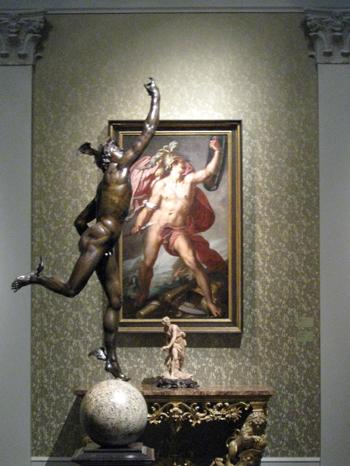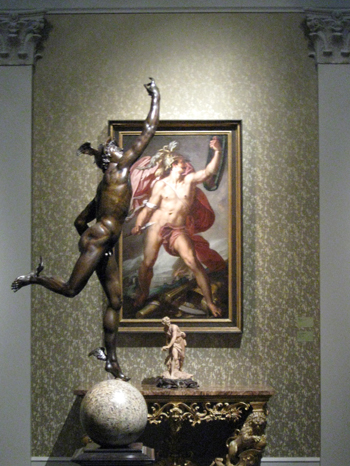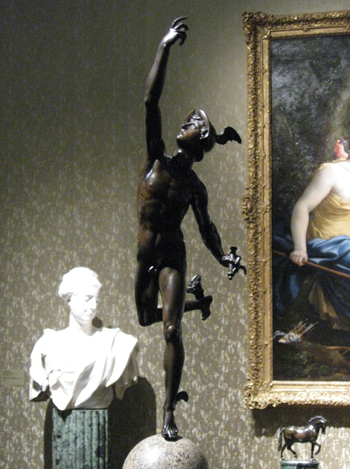I've walked through the Eye for the Sensual exhibition a few times now, and each time I do it seems to come more and more into focus. The first time through all I really took in, to be honest, was Pier Luigi Pizzi's exhibition design—the columns, the fabric walls, the mirrors, the beautiful colors—and the feeling that I was being overwhelmed by amazing art. The paintings, the sculptures, the furniture... there's a lot to take in in every gallery.
On my second trip through, I was able to take a little more time to consider the different artworks. That's when I noticed this little visual rhyme in the second gallery:
That's a sculpture by Giambologna in the foreground, called Flying Mercury, from the 1580s. On the wall behind it is Mars, from 1585–1600, by an unknown artist ("Netherlandsish," the label says). The photo is a bit misleading—Mercury is just two feet tall, while Mars' canvas is a little more than five and a half feet tall. It feels larger than life in person, helped in no small part by the figure's muscular countenance.
But the manner in which they are placed in the gallery, playing off each other visually, makes them feel in some ways equal, or at least related. Both have the outstretched arm, both nude, both Roman gods. Mercury's eyes are turned upward, as if he is reaching for something; Mars is looking out, toward the surrounding destruction (a fire rages in the background), his shield aloft in victory.
I was curious to know if there was anything to this pairing, or if the exhibition curators were just riffing, so I went to the exhibition catalogue. While there isn't a direct connection between the two works, the catalogue entry for Mars does discuss the influence of sculpture on the painting: "In keeping with innovations in the representation of anatomy circulating in the Netherlands in the late 16th century, particularly among sculptors, the monumentality and three-dimensional presence of Mars are intended to showcase the painter's skill in representing the male form in dynamic action." The entry goes on to point to the influence of sculptor Willem Danielsz. van Tetrode, whose depictions of Roman gods in action influenced both painters and sculptors at this time, including Giambologna, the artist behind Flying Mercury.
Intrigued, I searched the museum's collection for Tetrode and found that we have our very own Mercury on view in the newly reinstalled European galleries in the Ahmanson Building. So I headed for the Ahmanson's third floor and found Tetrode's Mercury front and center in a gallery just off from the Carter Collection galleries. I immediately noticed the similarity to Giambologna's, though Tetrode's Mercury isn't looking skyward.
As I was looking at the sculpture, thinking about how it might have influenced the artists in the Resnick Collection, I realized I wasn't alone in the gallery. "You've stopped in front of my favorite work in the gallery." It was Gail, one of the guards in those galleries. "A lot of people walk right past this," she said. We chatted for a few minutes about the new galleries, the Tetrode, and a few of her other favorites.
"What do you like about the Tetrode?" I asked, and she proceeded to identify exactly what it was that the artists of the time also found so amazing—its "extreme posture," to borrow a phrase from the Mars entry I'd read an hour earlier.
"I love this piece because it does something that the paintings, and even many of the sculptures [in these galleries], don't do. You can look at it from any angle and see that every limb is doing something different—the outstretched arm here, the bent elbow there, the leg in motion."
She was right. The Mercury felt active—it had a visceral quality to it. I spent a little more time with it, then headed back to the Resnick galleries to look at Flying Mercury and Mars once more—as if I were walking a dotted line from one gallery to the other.







